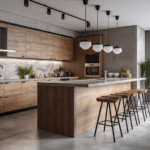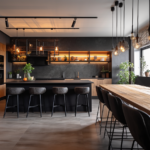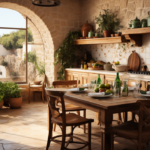Table of Contents
Discover the Essential Factors to Consider When Selecting the Ideal Kitchen Hood for Your Residence
If you’re someone who enjoys cooking up a storm in the kitchen, you know how important it is to have a good range hood to keep your space clean and comfortable. But with so many options out there, choosing the best kitchen hood for your home can feel like a daunting task. That’s why we’re here to help! In this article, we’ll guide you through the essential factors you need to consider when selecting your ideal kitchen hood. From size and ventilation power to noise level and style, we’ve got you covered. So, let’s get started and find you the perfect kitchen hood!
– Why You Need a Kitchen Hood
Why You Need a Kitchen Hood
Cooking can be messy, especially if you’re fond of cooking dishes that require a lot of oil or spices. As a result, it’s essential to have a good kitchen hood, also known as a range hood, to help keep your kitchen tidy. But, why else do you need a kitchen hood?
Here are a few primary reasons why you need a kitchen hood:
Removes Smoke and Odors
Cooking can produce a lot of unpleasant odors and smoke, which can make your kitchen feel stuffy and uncomfortable. A kitchen hood removes these odors and smoke, ensuring that your kitchen remains fresh and pleasant.
Improves Indoor Air Quality
Kitchen hoods are designed to filter out harmful particles such as carbon monoxide and other toxic chemicals that can accumulate when cooking over high heat. By eliminating these particles, a range hood helps to promote good indoor air quality.
Prevents Grease Buildup
Grease buildup can be a common problem in any kitchen. The residue can accumulate on walls and other surfaces, making cleanup a daunting task. A kitchen hood helps to prevent grease buildup by capturing grease particles before they land on the kitchen surfaces.
Offers Protection from Fire
Using a kitchen hood with venting options can help protect your kitchen from the risk of fire. By removing hot air and smoke from the cooking area, a kitchen hood can reduce the risk of fire.
In conclusion, choosing the right kitchen hood can help make your kitchen inviting, comfortable, and safer. Understanding why you need a range hood is the first step to finding the perfect range hood for your home. In the next section, we’ll dive into the essential factors you need to consider when selecting a kitchen hood.
– Types of Kitchen Hoods
Types of Kitchen Hoods
When it comes to selecting a kitchen hood, there are different types of hoods to choose from. Here are some of the most common and popular types of kitchen hoods:
- Wall-Mounted Chimney Hood – This type of hood is fixed on the wall and is perfect for cooktops or stovetops located against the wall.
- Island Hood – This hood is suspended from the ceiling and is perfect for kitchen islands where there is no wall behind the cooktop.
- Downdraft Vent – This hood sucks the air downwards through a vent, hidden within the cooktop, and is perfect for kitchen islands.
- Under-Cabinet Hood – This type of hood fits under the cabinet and is relatively low profile with simple design.
- Insert Hood – This hood is built-into the cabinetry, and is concealed by a panel that matches the cabinets.
When selecting the type of kitchen hood, it’s important to consider the placement of the cooktop or the stovetop, as well as the existing kitchen setup. A well-chosen hood will provide sufficient ventilation and help you maintain a clean and healthy cooking environment.
– Sizing Your Kitchen Hood
Essential Aspects of Choosing the Best Kitchen Hood for Your Home: Sizing Your Kitchen Hood
Choosing the right size of your kitchen hood is crucial to ensure that it operates efficiently and effectively. If your kitchen hood is too small, it won’t be able to capture all of the smoke, grease, and steam generated from your cooking. On the other hand, if the hood is too large, it can result in unnecessary noise, increased energy consumption, and reduced suction power.
Consider Your Stove Size
The primary factor to consider when sizing your kitchen hood is the size of your stove. Ideally, the hood should be equal to or greater than the stove’s width. The general rule of thumb is that if your stove is less than 30 inches wide, your hood should be approximately the same size as your cooktop. If your stove is larger than 30 inches, add six inches to your hood size for every additional foot.
Calculate Your Kitchen’s CFM Requirements
Another important factor when sizing your hood is determining the cubic feet of air per minute (CFM) your kitchen requires. It refers to the amount of air a hood fan can move in a minute. The higher the CFM rating of the hood, the more air it can move and the more effective it is at removing smoke, steam, and other fumes.
To calculate your kitchen’s CFM requirements, multiply the width and length of your kitchen in feet and then by eight. It’s recommended to choose a hood with a higher CFM rating if you frequently cook with high-heat or greasy food.
Final Thoughts
Sizing your kitchen hood is an essential step in choosing the best one for your home. It helps ensure that it operates efficiently and effectively in removing smoke and eliminating unwanted odors and fumes. By following the guidelines above and determining your stove size and the CFM requirements of your kitchen, you can make the right decision on the size of the hood you need for your kitchen.
– Ventilation Power and Noise Level
Ventilation power and Noise level
Proper ventilation in your kitchen is crucial to maintaining clean air and avoiding unpleasant odors while cooking. A good range hood should have an adequate ventilation power to remove smoke, grease, and steam from the air effectively. Ideally, you want a kitchen hood that can move at least 100 CFM (cubic feet per minute) of air for every 12 inches of stovetop space. However, depending on the size of your kitchen and your cooking habits, you may need a more powerful range hood to suit your needs.
On the other hand, the noise level of a kitchen hood is a significant consideration for many homeowners. While a more potent range hood may provide better ventilation, it may also come with louder operation noise, which can be disruptive to your cooking experience. Range hoods typically range between 50 and 70 decibels, with quieter models falling on the lower end of the spectrum. Ultimately, it would help if you balanced the ventilation power you need with the amount of noise you are willing to tolerate.
When shopping for a kitchen hood, look for models that offer varying fan speed options to adjust the ventilation power as per your requirements.
Conclusion
In conclusion, choosing the best kitchen hood for your home involves considering several essential aspects such as types of kitchen hoods, sizing, ventilation power, and noise level, among others. Careful consideration of these factors will help you select a range hood that suits your kitchen’s needs and enhances your cooking experience. Remember, a well-chosen kitchen hood can make all the difference in keeping your kitchen clean, comfortable and healthy.
Conclusion
In conclusion, finding the perfect kitchen hood for your home can significantly improve your cooking experience and keep your kitchen smelling fresh and clean. By considering crucial factors such as type, size, ventilation power, and noise level, you can make an informed decision and select the kitchen hood that best meets your needs. Don’t forget to choose a style that complements your kitchen design and fits within your budget. With the right kitchen hood, you can enjoy cooking all of your favorite meals without worrying about smoke, steam, or lingering odors. So what are you waiting for? Start your search today and upgrade your kitchen with the best kitchen hood for your home!









